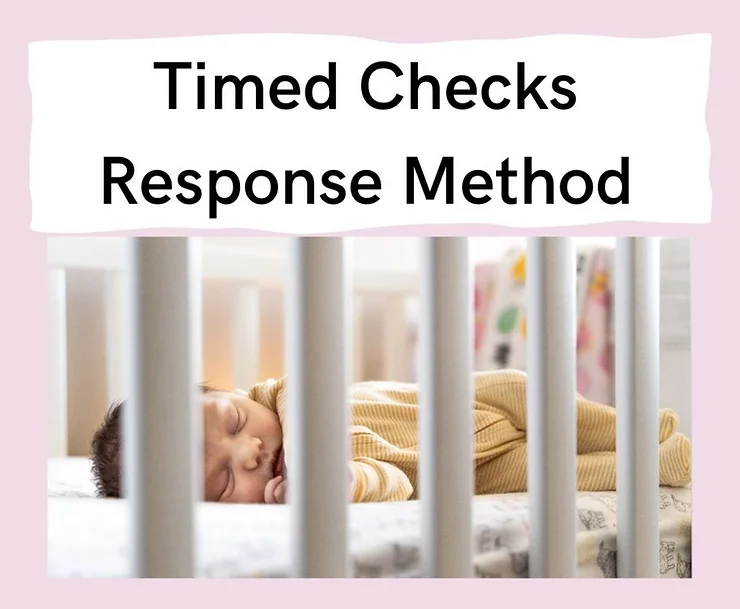A moderately involved sleep training method is the most popular choice for parents who are comfortable giving their children space to learn a new skill in a safe, loving, and supportive environment – but are not so comfortable to allow an unlimited time for them to be left alone with their potentially very big feelings.
The Timed Checks method is the perfect choice for the majority of parents I work with because it is so modifiable.
It involves leaving calmly and confidently the room after the end of the perfectly predictable bedtime routine. However, once your child starts to protest and exhibit those big feelings (because change is hard!) the timer starts. You will have already decided on the amount of time that you feel comfortable allowing your child to protest the new boundaries around sleep alone. This initial increment of time can be as small as 1-2 minutes, or whatever you feel comfortable with and agree on with your partner.
Let’s say, 2 minutes initially because you want the opportunity to remind your child that all is well even though they are upset. If your child has been upset in their safe sleep space for a full 2 minutes, then one parent will open the door to their bedroom and remind them, calmly, lovingly, and confidently, that it is time for sleep. Remind them with your voice only, and without getting too close that they are safe and loved, and even if they are having a hard time, you know they will be asleep soon.
It’s so very helpful to practice staying near the door during these checks so you are not misleading your child into thinking they are about to be picked up. This is often much more upsetting than simply staying by the door so it is very clear you are not about to pick them up, rock them or feed them to sleep. You are simply reminding them that they have all the tools they need, and even if they are very upset, it is OK and you know they can do it.
Once you offer a brief reminder of their safety and the opportunity to demonstrate your calm, it’s time to leave the room again and give them a bit more time to practice the new skill of falling asleep independently. For example, if you offered only 2 minutes for that first increment of time, you might feel comfortable offering a full 5 minutes. You will start your timer now for 5 minutes and if your child is still full on protesting at the 5 minute mark, you will take a deep breath to find your calm, and provide another boring check from the door. If your child is still upset after this second check, you will leave the room again and re-set your timer for a slightly larger increment of time, and the provide predictably boring checks from the door every – let’s say 10 minutes – until your child’s protests either downgrade or until they fall asleep. They will!
Keep in mind that the more time you allow them to practice uninterrupted, the faster the process goes and the less crying there tends to be cumulatively. However, we are balancing their need for more space with a parent’s preference to be somewhat involved. Some children will genuinely be soothed by a parents’ checks, while others will be more upset by the interruption in the falling to sleep process.
One great benefit of this method is that it can be continually modified to allow for more space when that is what works best for the child. Alternatively, you can continue with the initial nights’ checks increments if you find that is what works best for your child. I LOVE a modifiable plan.
Timed checks will be the exact same way you will respond to all night wakings as well until your previously agreed upon OK to Wake time. If one night feed is appropriate, a caregiver will offer that feed immediately at the baby’s first waking after midnight. We never want a baby to think they need to cry for any amount of time time before they are fed.
It’s also helpful to consider who is going to be doing those timed checks from the door. Oftentimes, there is one parent in the family who has a harder time holding firm boundaries, and is also the parent that does the bulk of the middle of the night soothing. In this type of family dynamic, there may also be another parent that has an easier time holding firmer boundaries. It is always helpful to have the parent who tends to have an easier time holding firmer boundaries be the parent who performs those checks from the door. Not only will this parent have an easier time staying consistent, but the child tends to also have an easier time accepting firm boundaries from this parent. And then the parent who will have a harder time with this process, is freed up to focus on other more distracting activities or to leave the house altogether and have wine with a close and
non-judgemental (!) friend 🙂
I also work with many families who report no difference in boundary holding abilities, or who prefer to share the load equally for whatever reason. It’s also OK to take turns with checks so no one is ending up more or less sleep deprived! It is important, however, that you are not alternating parents until your child has already fallen asleep. You do not ever want your child thinking that they will get to see Mom after crying for any amount of minutes. Instead, you might say one parent takes bedtime, while the other parent takes the first night waking, and so on until morning.
The Timed Checks method of sleep training is my personal favorite as a sleep consultant because it is so modifiable, effective, and leads to a relatively quick learning process. It allows some parental involvement, which most families really need to feel they can stay consistent and get to the other side where sleep is easy and nights are long.
This method is excellent for teaching babies over the age of 4 months, toddlers, and preschool aged children independent sleep skills. However, the response method is only one part of the healthy sleep equation or puzzle. It’s even more important to ensure that sleep hygiene has been fully addressed, as well as age appropriate preparation and celebration for our big kids.
If you feel ready to make a change and have regular long nights of sleep back for the whole family, don’t hesitate to ask for help. Take a look at the sleep support services I offer, and schedule a free 15 minute discovery call to learn more about the best way I can help you reach your goals.

